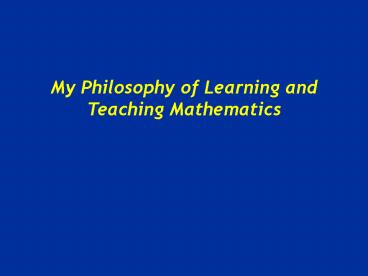My Philosophy of Learning and Teaching Mathematics - PowerPoint PPT Presentation
1 / 11
Title:
My Philosophy of Learning and Teaching Mathematics
Description:
My Philosophy of Learning and Teaching Mathematics. Start with 2 identical sheets ... Make another silo from the second sheet, by taping the short sides together. ... – PowerPoint PPT presentation
Number of Views:46
Avg rating:3.0/5.0
Title: My Philosophy of Learning and Teaching Mathematics
1
My Philosophy of Learning and Teaching Mathematics
2
Start with 2 identical sheets of paper.
Tape the long sides of one sheet together to form
an open silo. Make another silo from the
second sheet, by taping the short sides together.
Which silo will hold the most? Explain your
reasoning.
(Problem adapted from Lappan, et al.)
3
- Piaget
- At each stage of development, the learner has
- a characteristic way of viewing the world and
- explaining it to him/herself.
- In order to let go of a conflicting theory, the
- learner must resolve cognitive dissonance.
- Vygotsky
- Learners ideas may be pushed by teachers
- and peers, within a Zone of Proximal
Development. - Role of culture and social interaction in
learning.
4
The desire to share knowing with another
human being is a fundamental one. It is at heart
a desire to make your thoughts known to the
other and to learn whether they are understood,
even shared always with the chance that I will
mean more than I meant before because of the way
the other has understood. Deanna Kuhn, 1996
In a 1994 study of college students (Geil
and Moshman) a correct problem solution was given
by 75 of the groups, but only 9 of the
individuals. In three-eighths of the
correctly-responding groups, no individual had
initially exhibited the correct response.
5
The principle problem of human memory is
not storage, but retrieval. The key to retrieval
is organizationmaterial that is organized in
terms of a persons own interests and cognitive
structures has the best chance of being
accessible in memory. In a study of 12-year-old
children, asked to remember pairs of words, those
who created their own mediators remembered many
more pairs than those with no mediators, or
mediators provided to them.
6
I have never seen anybody improve in the art and
technique of inquiry by any means other than
engaging in inquiry. Jerome Bruner
7
Implications of learning theories for instruction
8
- Implications of learning theories for instruction
- Design activities which push the learners level
of - understanding, and confront learner
misconceptions.
9
- Implications of learning theories for instruction
- Design activities which push the learners level
of - understanding, and confront learner
misconceptions. - Design instruction which causes learners to
actively - practice the art of inquiry.
10
- Implications of learning theories for instruction
- Design activities which push the learners level
of - understanding, and confront learner
misconceptions. - Design instruction which causes learners to
actively - practice the art of inquiry.
- Provide opportunities for spoken and written
discourse.
11
The End































